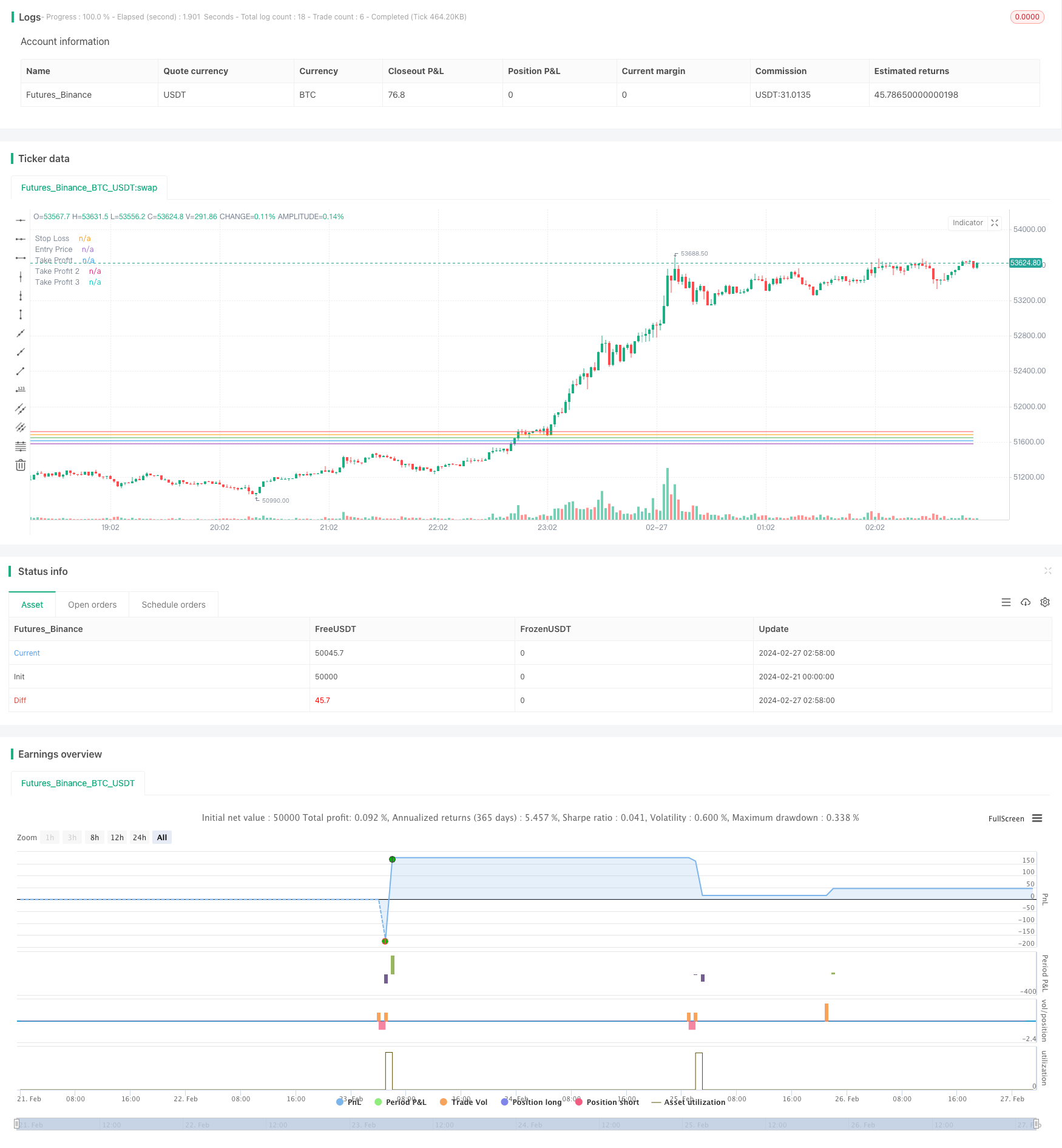
概述
该策略结合使用超级趋势指标和费雪变换,在市场反转的时候寻找短线做空机会。它可以通过调整超级趋势和费雪变换的参数,适用于不同的加密货币、股票和市场。当卖出信号出现时,它显示持仓规模和止损位以及获利位。您也可以调整风险金额。
策略原理
该策略首先计算10周期的费雪变换。当费雪变换线从低点向上突破2.5时,产生卖出信号。 同时,它计算10周期的平均真实波幅作为超级趋势通道。当价格从上轨下穿时,产生卖出信号。所以,该策略结合费雪变换指标和超级趋势通道,在市场出现反转时寻找做空机会。
具体来说,它计算当前K线收盘价在上一周期的超级通道上轨之下,并且上一周期在通道下轨之上时,判断为市场反转,产生卖出信号。同时,计算费雪变换指标,当费雪变换线从低点突破2.5,并且上一周期费雪变换值低于当前值时,判断为趋势反转,产生卖出信号。
所以,该策略需要同时满足超级趋势判断市场反转和费雪变换判断趋势反转两个条件,才会产生最终的卖出信号。
策略优势
该策略结合超级趋势通道和费雪变换指标,可以更准确地捕捉到市场的反转点。相比单一使用超级趋势或费雪变换,它可以减少假信号,从而提高策略的稳定性。
另外,该策略提供了调整超级趋势通道和费雪变换参数的灵活性。用户可以根据不同的市场和品种,选择最佳的参数组合,从而针对性地拟合市场。这是一个可以自定义优化的策略。
该策略也提供了风险金额管理。用户可以方便地调整每单的风险资金数量,实现自己的风险管理要求。同时,它也自动计算了止损位和获利目标,可以实现较好的风险回报率。
策略风险
该策略主要依赖超级趋势通道判断市场结构。当趋势持续阶段较长时,超级通道可能会失效。这时,应该适当调大通道的周期参数或ATR倍数。
另外,费雪变换比较容易产生错误信号或过早信号。当市场波动较大时,应该适当调整费雪变换的周期参数,过滤掉部分噪音。
此外,反转类策略的总体胜率可能比较有限。应该结合趋势跟踪指标,避免在震荡区间打开仓位,或者在趋势更加明确之后再参与。可以增加移动平均线作为过滤器,提高策略稳定性。
策略优化方向
该策略可以从以下几个方面进行优化:
优化超级趋势通道的ATR周期数和ATR倍数,针对不同品种和市场条件选择最佳参数组合
优化费雪变换的周期参数,平滑曲线降噪,防止产生错误信号
增加移动平均线或布林带作为辅助指标,避免震荡市场开仓
结合不同时间周期的费雪变换,实现更稳定可靠的反转判断
增加仓位管理模块,例如杠杆比例、仓位数量、加仓规则等,控制风险
结合机器学习等方法,实现参数的自动优化和策略拟合
总结
该策略融合超级趋势和费雪变换指标,在判断市场反转的同时具有一定的灵活性,可以通过参数调整适应不同品种。相比单一指标,它实现更可靠的信号判断和风险控制。通过持续优化,该策略有望进一步增强稳定性并提高盈利能力。它是一个值得长期跟踪和积累的高质量策略。
/*backtest
start: 2024-02-21 00:00:00
end: 2024-02-27 03:00:00
period: 2m
basePeriod: 1m
exchanges: [{"eid":"Futures_Binance","currency":"BTC_USDT"}]
*/
//@version=5
strategy("Supertrend and Fisher_SHORT", overlay=true)
//This block is for Fisher Transformation Calculation.
len = input.int(10, minval=1, title="Length") // Length is optional. 10 is good but is up to you.
high_ = ta.highest(hl2, len)
low_ = ta.lowest(hl2, len)
round_(val) => val > .99 ? .999 : val < -.99 ? -.999 : val
value = 0.0
value := round_(.66 * ((hl2 - low_) / (high_ - low_) - .5) + .67 * nz(value[1]))
fish1 = 0.0
fish1 := .5 * math.log((1 + value) / (1 - value)) + .5 * nz(fish1[1])
fish2 = fish1[1]
// Sell condition for Fisher transformation.
sell_signal = (fish1 > 2.5) and (fish2 > fish1)
durum = 0 //just for the situation.
if (sell_signal)
durum := -1 // now it changes from 0 to -1.
// Supertrend indicator inputs and calculations (same as in the indicator)
Periods = input(title='ATR Period', defval=10) // period is 10, but you can change it
src = input(hl2, title='Source')
Multiplier = input.float(title='ATR Multiplier', step=0.1, defval=2) //atr multiplier is important. it is 2 for this strategy but you can find another for best performance
RiskAmount = input.float(title='Risk Amount ($)', defval=10.0, minval=0.0, step=1.0) // ıf you use risk-reward method, risk is 10$ for each position. you can also change it
changeATR = input(title='Change ATR Calculation Method ?', defval=true)
atr2 = ta.sma(ta.tr, Periods)
atr = changeATR ? ta.atr(Periods) : atr2
up = src - Multiplier * atr
up1 = nz(up[1], up)
up := close[1] > up1 ? math.max(up, up1) : up
dn = src + Multiplier * atr
dn1 = nz(dn[1], dn)
dn := close[1] < dn1 ? math.min(dn, dn1) : dn
trend = 1
trend := nz(trend[1], trend)
trend := trend == -1 and close > dn1 ? 1 : trend == 1 and close < up1 ? -1 : trend
// Calculate position size based on risk amount
riskPerContract = atr * Multiplier
contracts = RiskAmount / (riskPerContract * syminfo.mintick)
//short signal condition
sellSignal = trend == -1 and trend[1] == 1 and durum == -1
plotshape(sellSignal, title='Sell Signal', location=location.abovebar, color=color.red, style=shape.triangledown, size=size.small) //shows the signal.
// variables
var float entryPrice = na
var float stopLoss = na
var float takeProfit = na
var float atr1 = na
var float takeProfit2 = na
var float takeProfit3 = na
//it calculates the stop level and reward profit levels using atr.
if (sellSignal)
entryPrice := close
atr1 := atr
stopLoss := entryPrice + atr1 * Multiplier
contracts := entryPrice / (stopLoss - entryPrice) * RiskAmount / entryPrice
takeProfit := entryPrice - atr1 * Multiplier
takeProfit2 := entryPrice - 2 * atr1 * Multiplier
takeProfit3 := entryPrice - 3 * atr1 * Multiplier
if (sellSignal)
strategy.entry("Sell", strategy.short, qty=1)
//
if (close >= stopLoss)
strategy.close("Sell", comment="Stop Loss Hit")
else if (close <= takeProfit)
strategy.close("Sell", comment="Take Profit Hit")
// draw the stop, entry and profit levels
plot(stopLoss, title="Stop Loss", color=color.red, linewidth=1, style=plot.style_linebr)
plot(entryPrice, title="Entry Price", color=color.orange, linewidth=1, style=plot.style_linebr)
plot(takeProfit, title="Take Profit", color=color.green, linewidth=1, style=plot.style_linebr)
plot(takeProfit2, title="Take Profit 2", color=color.blue, linewidth=1, style=plot.style_linebr)
plot(takeProfit3, title="Take Profit 3", color=color.purple, linewidth=1, style=plot.style_linebr)